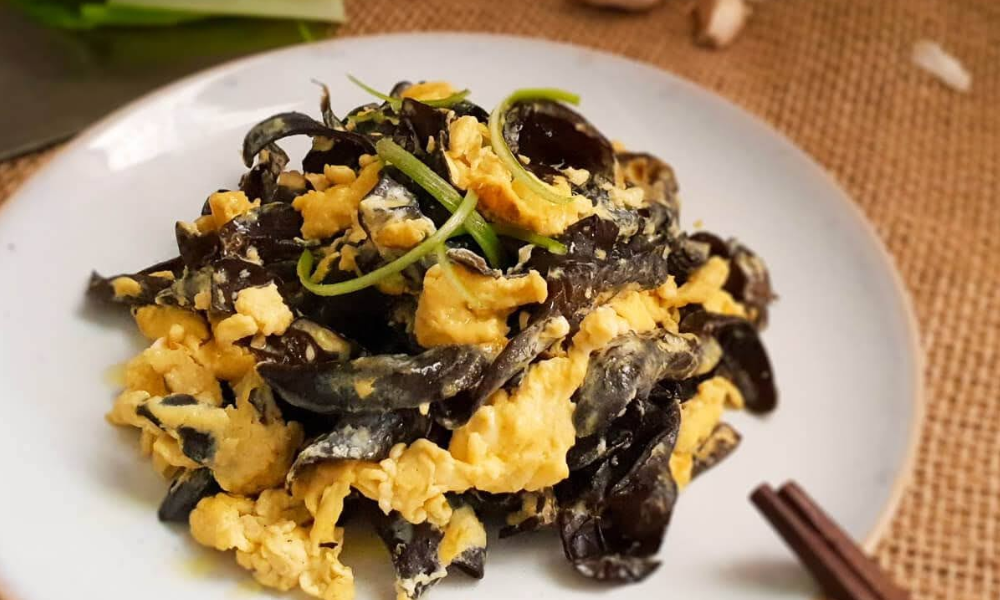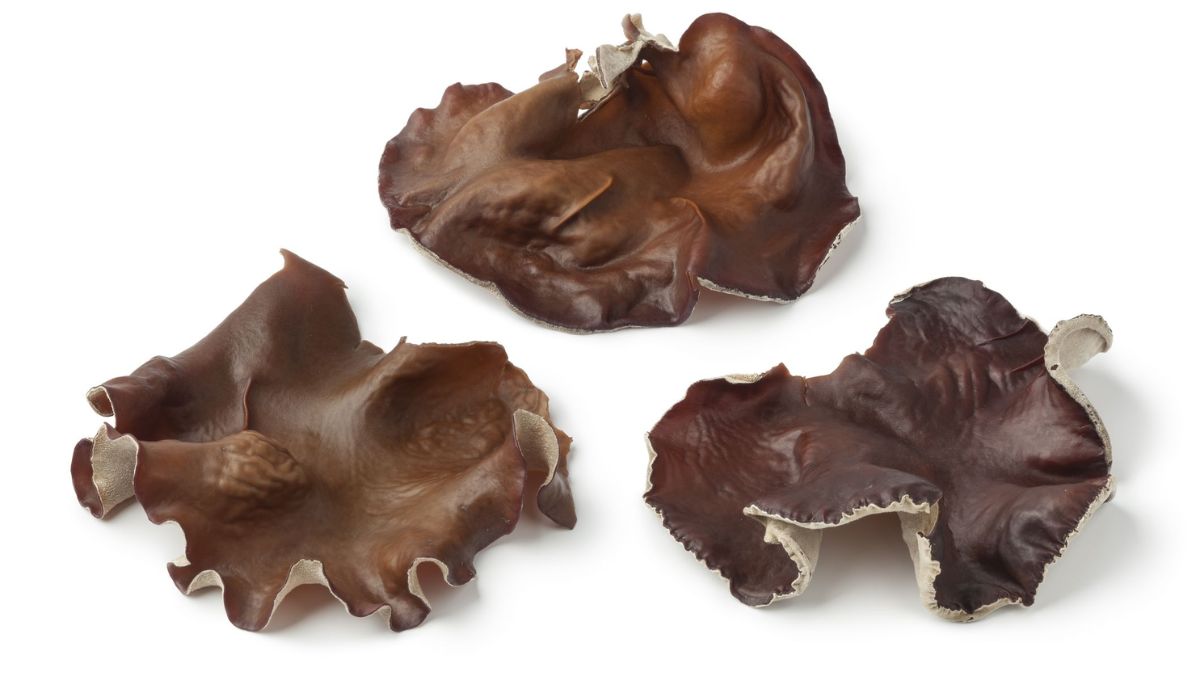The wood ear mushroom is a fungus that grows on the bark of elder trees. As it grows, it looks like a small brown ear. This type of mushroom is often used in Chinese cooking because it has a crunchy texture and soaks up flavors. Wood ear mushrooms are a traditional part of the hot and sour soup, Chinese stir-fry, and mu shu pork. It doesn’t have much flavor, but because it has so many cracks, and good for letting sauces soak into it.
What are Wood Ear Mushrooms?
Wood ear mushrooms are fungi that range in color from dark brown to light brown and look like small, crinkled ears. This mushroom grows on trees and shrubs that lose their leaves in the fall, mostly the elder tree. People who look for mushrooms often find this one on fallen and rotting trees, where it grows alone or in large colonies. The best time to find wood ear mushrooms is in the fall.
This fungus likes to grow in temperate and subtropical forests. The wood ear is a popular ingredient in Chinese cooking and grows in Australia, Asia, Europe, and Africa. Wildwood ears are sought after, but the mushroom can also be grown on sawdust logs on a farm.
Wood ear mushrooms (Auricularia auricula-judge) are a type of mushroom native to Asia. The wood ear mushroom is called that because, when it is fresh, it looks a lot like a small brown ear. This mushroom is also called “jelly ear,” “kikurage,” and “hei mu-er” in Japan and China, respectively.
Also known as jelly ear mushrooms, kikurage, and tree ear fungus, the wood ear mushroom is named for the ear-like folds on its fruiting body. Wood ear mushrooms are a popular ingredient in Chinese cooking. When cooked properly, wood ear mushrooms have a slightly crunchy texture and a chewy feel on the inside.
How to Cook with Wood Ear Mushrooms?
Wood ear mushrooms are often sold dried and need to be rehydrated before they can be used in cooking. To do this, gently rinse the mushrooms and then put them in a bowl of warm water to cover them completely. Let the wood ear mushrooms soak for about 30 minutes until they are soft, bendable, and three to four times as big as before. Once the wood ear is ready, cut off any hard parts. It should feel firm but also be able to bend like gelatin.
Once the wood ear mushrooms have been rehydrated and trimmed, they can be used like fresh fungi, but they shouldn’t be eaten raw. Unless it’s going into a hot soup, it’s best to parboil or steam the mushroom before adding it to a dish. You can leave it whole or cut it up depending on the mushroom’s size and what else is on the menu. For dishes like hot and sour soup, wood ear mushrooms should stay in big chunks or be left whole if they are small. Most of the time, wood ear mushrooms are best when they are cut into bigger pieces. This is because their rubbery texture adds flavor to food, soaks up sauces, and holds pockets of flavor within the folds of the fungi.
Wood ear mushrooms are great in salads because they have a natural crunch. This mushroom tastes great in stir-fry, mu shu pork, or scrambled eggs. And because it soaks up flavors, the wood ear mushroom goes well with all kinds of Asian-style rice and noodle dishes. In general, wood ear mushrooms go well with fermented black beans, oyster sauce, soy sauce, ginger, sesame oil, onion, cucumber, peas, tofu, seafood, pork, chilies, potatoes, and eggs.
Wood ear mushrooms are a versatile ingredient to include in various dishes.
1. Rehydrate your wood ear mushrooms- You might be able to find fresh wood ear mushrooms in some Asian markets, but most wood ear mushrooms you buy in stores are dried. Soak your dried wood ear mushrooms in cold water for up to two hours or until they grow back to their full size.
2. Rinse the mushrooms- Rinse each wood ear mushroom under cold running water from the faucet. If any stems are very tough or spongey, throw them away.
3. Blanch the mushrooms- Bring a pot of water to a boil and blanch the mushrooms for 3–5 minutes. If you’re making a stir-fry or rice bowl, you could add your boiled wood ear mushrooms to a hot pan for more cooking.
4. Add the mushrooms to your meal- Many Asian dishes, like hot and sour soup, dumplings, and moo shu pork, taste great with wood ear mushrooms. Wood ear mushrooms taste good with soy sauce, cilantro, and sesame oil, among other things. If you can’t find wood ear mushrooms at your local grocery store, you can use other types of mushrooms instead. Cloud ear mushrooms, oyster mushrooms, and shiitake mushrooms are all good options.
5. Store leftover dried mushrooms- Use wood ear mushrooms as soon as they have been rehydrated. If you have leftover wood ear mushrooms, put them somewhere cool and dry. Dried wood ears can last for months if they are kept correctly.
Wood Ear Mushroom Recipes
Wood ear mushrooms are a common ingredient in Chinese food. They are often used in hot and sour soup. This fungus can also be used in place of other mushrooms in these recipes. It doesn’t have much taste on its own, but it gives a variety of foods a satisfying crunch and texture.
- Hot and Sour Soup
- Mu Shu Pork
- Thai Mushroom Fried Rice
What does it Taste Like?
The wood ear mushroom doesn’t have much taste on its own. It’s a mild food that takes on the spices and flavors of the dishes it’s put in. The crunchiness of wood ear mushrooms is the main reason people eat them. It is a firm fungus that keeps its shape while cooking. The folds, which look like ears, can soak up flavors and hold the sauce. Wood ear mushrooms smell like grass and wood when raw, but they don’t taste very strong when cooked. You could also say that it tastes like the sauce it is cooked in. Wood ear mushrooms can add texture to a wide range of Chinese dishes.
Wood Ear Mushrooms vs. Black Fungus
Even though wood ear mushrooms and black fungi are made from fungi, they are different. Both wood ear mushrooms and black fungus, sometimes called cloud ear, grow in temperate, subtropical forests. Wood ear mushrooms grow on elder trees, while black fungus grows on other trees. Wood ear is thicker and bigger than black fungus and takes longer to cook. The smaller, more delicate black fungus can be cooked more quickly. But both are used in the same way and in the same foods, and one can be used in place of the other.
Where to Buy Wood Ear Mushrooms?
Fresh wood ear mushrooms are hard to find, and an Asian grocery store is the best place to look for them. It is much easier to find dried wood ear mushrooms, and any Asian market will have them. You can also order dried wood ear mushrooms on the internet. Even though wild wood ear mushrooms are highly sought after, dried farm-grown ones are more common in stores and on the internet.
How to Store Wood Ear Mushrooms?
Wood ear mushrooms that have been dried out should be kept in a cool, dry place that is out of direct light. It’s best to keep them in a container that can’t let air in so that no moisture can get in. Wood ear mushrooms that are still fresh can be kept in the fridge in a paper bag, mesh bag, or anything else that lets them move around and breathe. Wood ear mushrooms only last a few days when they are fresh, but when they are dried, they can be kept for months or even a year. Fresh mushrooms that have gone bad are easy to spot because they smell, feel mushy, and have black spots.
Nutritional Value and Flavor of Wood Ear Mushrooms
Wood-ear mushrooms are low in calories but high in protein and fiber. Wood ear mushrooms also have a lot of minerals, such as iron and magnesium, and a lot of B vitamins. Wood ear mushrooms taste mild and earthy by themselves. But the wood ear mushroom is a great addition to soups and stews because it easily takes on the flavors of other ingredients.
Conclusion
Wood Ear Mushrooms have a lot of bioactive compounds like polysaccharides that help the heart work better. They also have a lot of B complex vitamins. A study published in the journal “Mycobiology” found that it helps keep cholesterol levels in check and lowers the atherogenic index by 40%. Wood ear mushrooms are found all over Asia in temperate, humid forests. Wood ear mushrooms grow on dead and living trees, but most often on older trees. Farmers grow wood ear mushrooms on sawdust logs in parts of Europe, Africa, and North America that have the right weather.

